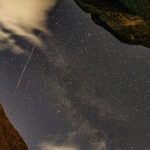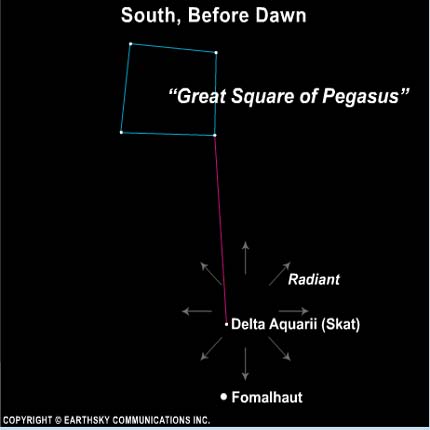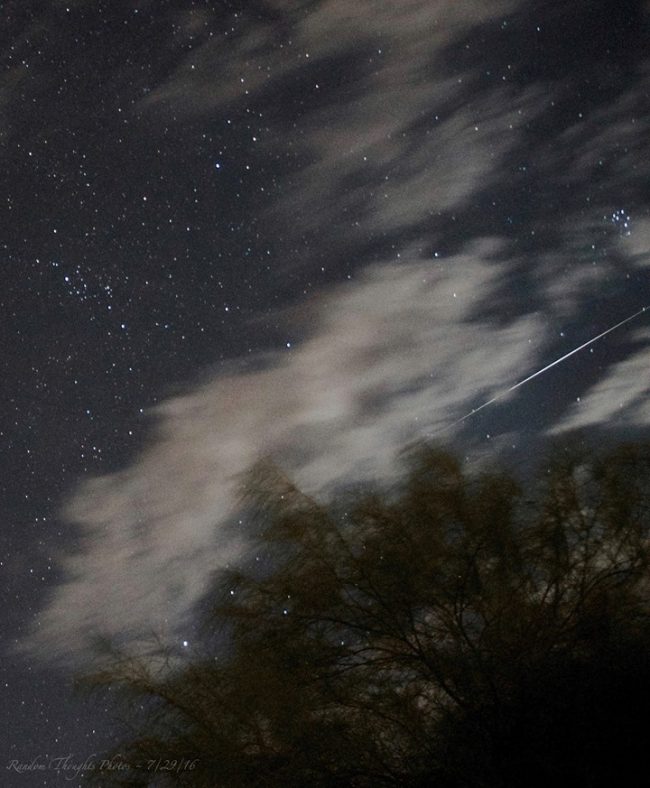

Meteors in annual showers happen when Earth encounters debris left behind by a comet. Astronomers have learned to calculate the various streams of debris in space, left behind by comets as various passages near the sun. Image by AstroBob.
Late July 2020 – around July 28 – presents the nominal peak of the Delta Aquariid meteor shower. But don’t let that date thwart you, if you have a chance to be in a dark place for meteor-watching, anytime before, while the moon is still a waxing crescent and setting in the evening hours. The shower offers more meteors after midnight and is best viewed during the predawn hours.
The long and rambling Delta Aquariid shower is officially active from about July 12 to August 23 each year. The coming new moon on July 31/August 1 (depending on your time zone) means lovely waning crescents in the optimum predawn hours in late July. It means dark skies throughout most of the night all through the first week of August.
The Delta Aquariid shower favors the Southern Hemisphere, though is still visible from mid-northern latitudes. In years when the moon is out of the way, the broad maximum of this shower can be expected to produce 10 to 20 meteors per hour. But, even in early August, you’ll likely see some Perseids, too. This shower overlaps with the more famous Perseid meteor shower, which in early August is rising to its peak (this year on the mornings of August 11, 12 and 13, though under the light of a wide waning crescent moon). Those who observe the Perseids are likely to see some Delta Aquariid meteors flying on the same nights.
For the Delta Aquariids, as for most meteor showers, the best viewing hours are after midnight and before dawn for all time zones around the world.
Everything you need to know: Perseid meteor shower

The radiant point for Delta Aquariid shower is near star Skat, or Delta Aquarii. This star is near in the sky to a much brighter star, Fomalhaut, which can be found roughly on a line drawn southward through the stars on the west side of the Great Square. This chart shows the Northern Hemisphere view. From the Southern Hemisphere, the radiant is closer to overhead. And don’t worry too much about radiant points. The meteors will appear in all parts of the sky.
How can I tell Perseid meteors from Delta Aquariid meteors? This is where the concept of a radiant point comes in handy. If you trace all the Delta Aquariid meteors backward, they appear to radiate from a certain point in front of the constellation Aquarius the Water Bearer, which, as viewed from the Northern Hemisphere, arcs across the southern sky. The radiant point of the shower nearly aligns with the star Skat (Delta Aquarii). The meteor shower is named in the honor of this star.
Meanwhile, the Perseids radiate from the constellation Perseus, in the northeast to high in the north between midnight and dawn. So – assuming you’re in the Northern Hemisphere – if you’re watching the Perseids, and you see meteors coming from the northeast or north … they are Perseids. If you see them coming from the south … they are Delta Aquariids. In a particularly rich year for meteors, if you have a dark sky, you might even see them cross paths! It can be an awesome display.
The Delta Aquariid meteors may tend to be a bit fainter than the Perseids and meteors seen in other major showers. That makes a dark sky free of moonlight even more imperative for watching the annual Delta Aquariid shower. About five to ten percent of the Delta Aquariid meteors leave persistent trains – glowing ionized gas trails that last a second or two after the meteor has passed. The meteors burn up in the upper atmosphere about 60 miles (100 km) above Earth’s surface.
Rememeber, you never have to locate a shower’s radiant point to enjoy the meteors. However, it does help to have a dark night without moonlight. This year – in 2020 – the Delta Aquariids at its peak in late July will be somewhat marred by a waxing gibbous moon, and August Perseids will be somewhat marred by the last quarter and wide waning crescent moon.

Comet 96P Machholz, the possible parent of the Delta Aquariid meteor shower, was discovered on May 12, 1986, by Donald Machholz. Image via Wikimedia Commons.
Delta Aquariid meteors may come from Comet 96P Machholz. Meteor showers happen when our planet Earth crosses the orbital path of a comet. When a comet nears the sun and warms up, it sheds bits and pieces that spread out into that comet’s orbital stream. This comet debris slams into the Earth’s upper atmosphere at about 90,000 miles (150,000 km) per hour, vaporizing – burning up – as meteors or shooting stars.
The parent body of the Delta Aquariid meteor is not known with certainty. It was once thought to have originated from the breakup of what are now the Marsden and Kracht sungrazing comets. More recently, Comet 96P Machholz has loomed as the primary candidate for being the Delta Aquariids’ parent body.
Donald Machholz discovered this comet in 1986. It’s a short-period comet whose orbit carries it around the sun once in a little over five years. At aphelion – its greatest distance from the sun – this comet goes out beyond the orbit of Jupiter. At perihelion – its closest point to the sun – Comet 96P Machholz swings well inside Mercury’s orbit. Comet 96P Machholz last came to perihelion on October 27, 2017, and will next come to perihelion on January 31, 2023.
Bottom line: The Delta Aquariid meteor shower lacks a very definite peak. It rambles along pretty steadily in late July and August, intermingling with the Perseids. The expected nominal peak happens in late July, and in 2020, comes a day or so after the first quarter moon on July 27, 2020. From any time zone, the best viewing window lasts for several hours, centered on roughly 2 a.m. (3 a.m. daylight saving time). Find an open sky away from artificial lights, lie down on a reclining lawn chair and look upward.
Everything you need to know: Perseid meteor shower
from EarthSky https://ift.tt/30Tf32p


Meteors in annual showers happen when Earth encounters debris left behind by a comet. Astronomers have learned to calculate the various streams of debris in space, left behind by comets as various passages near the sun. Image by AstroBob.
Late July 2020 – around July 28 – presents the nominal peak of the Delta Aquariid meteor shower. But don’t let that date thwart you, if you have a chance to be in a dark place for meteor-watching, anytime before, while the moon is still a waxing crescent and setting in the evening hours. The shower offers more meteors after midnight and is best viewed during the predawn hours.
The long and rambling Delta Aquariid shower is officially active from about July 12 to August 23 each year. The coming new moon on July 31/August 1 (depending on your time zone) means lovely waning crescents in the optimum predawn hours in late July. It means dark skies throughout most of the night all through the first week of August.
The Delta Aquariid shower favors the Southern Hemisphere, though is still visible from mid-northern latitudes. In years when the moon is out of the way, the broad maximum of this shower can be expected to produce 10 to 20 meteors per hour. But, even in early August, you’ll likely see some Perseids, too. This shower overlaps with the more famous Perseid meteor shower, which in early August is rising to its peak (this year on the mornings of August 11, 12 and 13, though under the light of a wide waning crescent moon). Those who observe the Perseids are likely to see some Delta Aquariid meteors flying on the same nights.
For the Delta Aquariids, as for most meteor showers, the best viewing hours are after midnight and before dawn for all time zones around the world.
Everything you need to know: Perseid meteor shower

The radiant point for Delta Aquariid shower is near star Skat, or Delta Aquarii. This star is near in the sky to a much brighter star, Fomalhaut, which can be found roughly on a line drawn southward through the stars on the west side of the Great Square. This chart shows the Northern Hemisphere view. From the Southern Hemisphere, the radiant is closer to overhead. And don’t worry too much about radiant points. The meteors will appear in all parts of the sky.
How can I tell Perseid meteors from Delta Aquariid meteors? This is where the concept of a radiant point comes in handy. If you trace all the Delta Aquariid meteors backward, they appear to radiate from a certain point in front of the constellation Aquarius the Water Bearer, which, as viewed from the Northern Hemisphere, arcs across the southern sky. The radiant point of the shower nearly aligns with the star Skat (Delta Aquarii). The meteor shower is named in the honor of this star.
Meanwhile, the Perseids radiate from the constellation Perseus, in the northeast to high in the north between midnight and dawn. So – assuming you’re in the Northern Hemisphere – if you’re watching the Perseids, and you see meteors coming from the northeast or north … they are Perseids. If you see them coming from the south … they are Delta Aquariids. In a particularly rich year for meteors, if you have a dark sky, you might even see them cross paths! It can be an awesome display.
The Delta Aquariid meteors may tend to be a bit fainter than the Perseids and meteors seen in other major showers. That makes a dark sky free of moonlight even more imperative for watching the annual Delta Aquariid shower. About five to ten percent of the Delta Aquariid meteors leave persistent trains – glowing ionized gas trails that last a second or two after the meteor has passed. The meteors burn up in the upper atmosphere about 60 miles (100 km) above Earth’s surface.
Rememeber, you never have to locate a shower’s radiant point to enjoy the meteors. However, it does help to have a dark night without moonlight. This year – in 2020 – the Delta Aquariids at its peak in late July will be somewhat marred by a waxing gibbous moon, and August Perseids will be somewhat marred by the last quarter and wide waning crescent moon.

Comet 96P Machholz, the possible parent of the Delta Aquariid meteor shower, was discovered on May 12, 1986, by Donald Machholz. Image via Wikimedia Commons.
Delta Aquariid meteors may come from Comet 96P Machholz. Meteor showers happen when our planet Earth crosses the orbital path of a comet. When a comet nears the sun and warms up, it sheds bits and pieces that spread out into that comet’s orbital stream. This comet debris slams into the Earth’s upper atmosphere at about 90,000 miles (150,000 km) per hour, vaporizing – burning up – as meteors or shooting stars.
The parent body of the Delta Aquariid meteor is not known with certainty. It was once thought to have originated from the breakup of what are now the Marsden and Kracht sungrazing comets. More recently, Comet 96P Machholz has loomed as the primary candidate for being the Delta Aquariids’ parent body.
Donald Machholz discovered this comet in 1986. It’s a short-period comet whose orbit carries it around the sun once in a little over five years. At aphelion – its greatest distance from the sun – this comet goes out beyond the orbit of Jupiter. At perihelion – its closest point to the sun – Comet 96P Machholz swings well inside Mercury’s orbit. Comet 96P Machholz last came to perihelion on October 27, 2017, and will next come to perihelion on January 31, 2023.
Bottom line: The Delta Aquariid meteor shower lacks a very definite peak. It rambles along pretty steadily in late July and August, intermingling with the Perseids. The expected nominal peak happens in late July, and in 2020, comes a day or so after the first quarter moon on July 27, 2020. From any time zone, the best viewing window lasts for several hours, centered on roughly 2 a.m. (3 a.m. daylight saving time). Find an open sky away from artificial lights, lie down on a reclining lawn chair and look upward.
Everything you need to know: Perseid meteor shower
from EarthSky https://ift.tt/30Tf32p



Aucun commentaire:
Enregistrer un commentaire